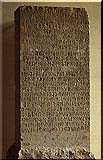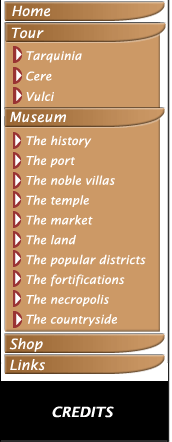|

Society
Typical of the Etruscan social order was the great level of
importance given to the rulers, which was shown in the solemnity
of the ceremonies underlining their public actions. The form
of the state was oligarchic, with collegial bodies of government,
with the highest magistrate, the lucumone, being elected for
a pre-established period from the noblest families. On the
other hand, the monarchic system, which was the most widespread
in the archaic period, continued in some cities.
The
lucumone combined the role of civil, military and religious
chief. The symbol of his authority was a fasces of rods with
an axe in the middle. Other symbols of power were a golden
crown, a sceptre, a purple mantle and an ivory throne. Little
is known about the social divisions of the Etruscan world:
we can distinguish between a class of masters, divided between
the aristocracy and the merchant class on the one hand and
a servile class, divided between free men and slaves. The
servile class never had the possibility of intervening directly
in running the state and gained only marginal advantage of
the wealth of the affluent classes. This clear-cut separation
represented a factor of weakness in times of crisis, undermining
the bases of that social cohesion necessary to resist external
dangers.

Trade
Placed in a pivotal region for trade between the Orient and
the West, the Etruscans were able to fully exploit this advantageous
position. With the control of the Tyrrhenian Sea ensured by
their fleet, Etruscan merchants were as famous as the Greeks
or Phoenicians to the peoples living along the coasts of the
Mediterranean. The overland commercial routes leading to the
north of Europe were also covered by Etruscan merchants who
thus acted as intermediaries between the advanced civilizations
of the eastern Mediterranean and the lesser developed peoples
of the west and the far-off north. The products for which
the Etruscans were best known were wine, vases, including
bucchero ware, bronze arms and treasures. To make trade and
the movement of troops easier, the Etruscan territories were
covered by a dense network of roads, some of which were built
with complex engineering works. Taking these roads towards
the north, the Apennines could be crossed to reach the plains
of the Po Valley; towards the south, they linked Etruria with
Etruscan Campania and the flourishing cities of the south
of Italy.

Coins
In the most remote times when trade was already flourishing,
the majority of exchanges were made by bartering. The first
means of exchange were pieces of copper or unrefined silver.
In the archaic period, when the economy was based essentially
on bartering, the few coins that circulated were Greek. The
systematic minting of coins began in the mid 5th century BC
and was concentrated in Populonia, in correspondence with
the richest mining area of the whole of Etruria. Only towards
the end of the 4th century BC, following the Roman example,
did the first coins of melted and minted bronze appear.

The
language
The incomprehensible nature of the language has contributed
to the creation of an aura of fascination and mystery around
the Etruscan civilization. In fact, although the alphabet
is clearly derived from the Greek one, the Etruscan language
appears to scholars as isolated in the historical context.
The dissatisfactory level of knowledge, which prevents us
from inserting it in a specific linguistic group, contributes
to creating uncertainty regarding the origin of the Etruscan
people. For
more than four centuries, from the 15th century to the present,
experts of linguistics and simple enthusiasts have tackled
the fragmentary Etruscan texts that have come down to us.
Today we can say that the enigma of the Etruscan language
has been at least partially solved, insofar as we know its
phonetics, the meaning of many words and we can reconstruct
some of the grammatical rules. If the level of our knowledge
allows us to understand the meaning of the texts in our possession,
it is equally true that we are incapable of reconstructing
their exact literal meaning. It is not a question of finding
a key of interpretation for a sudden full comprehension of
the Etruscan language, but of studying in depth the level
of analysis of the material we have at our disposal.
|



